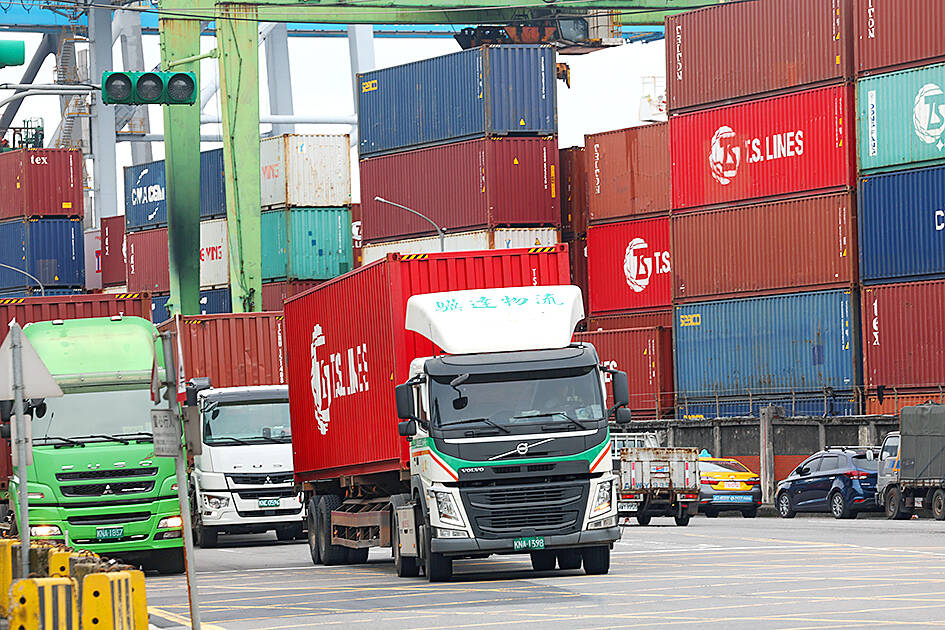Exports last month soared 18.9 percent year-on-year to US$41.82 billion, the highest for March, as demand for artificial intelligence (AI) products thrived, while the market for non-tech products improved, the Ministry of Finance said yesterday.
It is the first time in 19 months that exports rose above the US$40 billion mark, and they are expected to advance 8 percent to 11 percent this month, as the recovery gains further momentum, Department of Statistics Director-General Beatrice Tsai (蔡美娜) said.
The trade data last month was better than expected, thanks to fast-growing demand for AI, restocking demand for non-tech products and a low comparison base, Tsai said.

Photo: CNA
Shipments of information and communication technology (ICT) products in particular more than doubled to US$12.65 billion, accounting for 30.3 percent of overall exports, she said.
However, exports of electronic components, mainly chips, fell 5.5 percent to US$14.7 billion, which Tsai attributed partly to product reclassifications.
“It is perhaps better to combine electronics and ICT shipments to capture the latest technology cycle movements, which lent support to a more than 30 percent recovery,” she said.
Demand for ICT products came mostly from the US where major technology firms are speeding up the development of AI tools and services, she said, adding that the US was the nation’s second-largest trading partner with a 21.8 percent share of Taiwan’s total outbound shipments.
Shipments to China fell 1.3 percent to US$12.72 billion with a softening share of 30.4 percent, Tsai said, as Taiwanese firms rally behind US bans on sales of advanced technology products to China.
Exports to ASEAN markets soared 47.1 percent to US$2.66 billion with Thailand, Vietnam and elsewhere in the trade bloc benefiting from an ongoing realignment of the global electronics supply chain, she said.
Meanwhile, shipments of base metal, chemical, mineral and textile products gained 0.8 percent to 7 percent, emerging from a prolonged slowdown induced by sharp global inflation and monetary tightening, she said.
“The recovery will grow stronger and more broad-based,” she said.
Imports posted a 7.1 percent increase to US$33.14 billion, helped by fleet expansions by domestic airline companies to take advantage of rising demand for cross-border travel, Tsai said.
The positive showing in imports came even though purchases of capital equipment fell 12.6 percent overall, while the acquisition of semiconductor equipment plunged 50.1 percent, she said.
That was because local tech firms were cautious in capacity and inventory management, especially as interest rates remain high and geopolitical risks abound, she said.
The latest trade data gave Taiwan a surplus of US$8.68 billion last month, more than doubling from a year earlier, the ministry said.
In the first quarter, exports rose 12.9 percent year-on-year to US$110.33 billion, while imports increased 3 percent to US$91.38 billion, beating the government’s February forecast of an 8.36 percent rise and a 0.4 percent decline respectively.

NOT JUSTIFIED: The bank’s governor said there would only be a rate cut if inflation falls below 1.5% and economic conditions deteriorate, which have not been detected The central bank yesterday kept its key interest rates unchanged for a fifth consecutive quarter, aligning with market expectations, while slightly lowering its inflation outlook amid signs of cooling price pressures. The move came after the US Federal Reserve held rates steady overnight, despite pressure from US President Donald Trump to cut borrowing costs. Central bank board members unanimously voted to maintain the discount rate at 2 percent, the secured loan rate at 2.375 percent and the overnight lending rate at 4.25 percent. “We consider the policy decision appropriate, although it suggests tightening leaning after factoring in slackening inflation and stable GDP growth,”

DIVIDED VIEWS: Although the Fed agreed on holding rates steady, some officials see no rate cuts for this year, while 10 policymakers foresee two or more cuts There are a lot of unknowns about the outlook for the economy and interest rates, but US Federal Reserve Chair Jerome Powell signaled at least one thing seems certain: Higher prices are coming. Fed policymakers voted unanimously to hold interest rates steady at a range of 4.25 percent to 4.50 percent for a fourth straight meeting on Wednesday, as they await clarity on whether tariffs would leave a one-time or more lasting mark on inflation. Powell said it is still unclear how much of the bill would fall on the shoulders of consumers, but he expects to learn more about tariffs

Greek tourism student Katerina quit within a month of starting work at a five-star hotel in Halkidiki, one of the country’s top destinations, because she said conditions were so dire. Beyond the bad pay, the 22-year-old said that her working and living conditions were “miserable and unacceptable.” Millions holiday in Greece every year, but its vital tourism industry is finding it harder and harder to recruit Greeks to look after them. “I was asked to work in any department of the hotel where there was a need, from service to cleaning,” said Katerina, a tourism and marketing student, who would

i Gasoline and diesel prices at fuel stations are this week to rise NT$0.1 per liter, as tensions in the Middle East pushed crude oil prices higher last week, CPC Corp, Taiwan (台灣中油) and Formosa Petrochemical Corp (台塑石化) said yesterday. International crude oil prices last week rose for the third consecutive week due to an escalating conflict between Israel and Iran, as the market is concerned that the situation in the Middle East might affect crude oil supply, CPC and Formosa said in separate statements. Front-month Brent crude oil futures — the international oil benchmark — rose 3.75 percent to settle at US$77.01